Dawei Dai
Face-MakeUp: Multimodal Facial Prompts for Text-to-Image Generation
Jan 05, 2025Abstract:Facial images have extensive practical applications. Although the current large-scale text-image diffusion models exhibit strong generation capabilities, it is challenging to generate the desired facial images using only text prompt. Image prompts are a logical choice. However, current methods of this type generally focus on general domain. In this paper, we aim to optimize image makeup techniques to generate the desired facial images. Specifically, (1) we built a dataset of 4 million high-quality face image-text pairs (FaceCaptionHQ-4M) based on LAION-Face to train our Face-MakeUp model; (2) to maintain consistency with the reference facial image, we extract/learn multi-scale content features and pose features for the facial image, integrating these into the diffusion model to enhance the preservation of facial identity features for diffusion models. Validation on two face-related test datasets demonstrates that our Face-MakeUp can achieve the best comprehensive performance.All codes are available at:https://github.com/ddw2AIGROUP2CQUPT/Face-MakeUp
HumanVLM: Foundation for Human-Scene Vision-Language Model
Nov 05, 2024Abstract:Human-scene vision-language tasks are increasingly prevalent in diverse social applications, yet recent advancements predominantly rely on models specifically tailored to individual tasks. Emerging research indicates that large vision-language models (VLMs) can enhance performance across various downstream vision-language understanding tasks. However, general-domain models often underperform in specialized fields. This study introduces a domain-specific Large Vision-Language Model, Human-Scene Vision-Language Model (HumanVLM), designed to provide a foundation for human-scene Vision-Language tasks. Specifically, (1) we create a large-scale human-scene multimodal image-text dataset (HumanCaption-10M) sourced from the Internet to facilitate domain-specific alignment; (2) develop a captioning approach for human-centered images, capturing human faces, bodies, and backgrounds, and construct a high-quality Human-Scene image-text dataset (HumanCaptionHQ, about 311k pairs) that contain as much detailed information as possible about human; (3) Using HumanCaption-10M and HumanCaptionHQ, we train a HumanVLM. In the experiments, we then evaluate our HumanVLM across varous downstream tasks, where it demonstrates superior overall performance among multimodal models of comparable scale, particularly excelling in human-related tasks and significantly outperforming similar models, including Qwen2VL and ChatGPT-4o. HumanVLM, alongside the data introduced, will stimulate the research in human-around fields.
Granular-ball Representation Learning for Deep CNN on Learning with Label Noise
Sep 05, 2024



Abstract:In actual scenarios, whether manually or automatically annotated, label noise is inevitably generated in the training data, which can affect the effectiveness of deep CNN models. The popular solutions require data cleaning or designing additional optimizations to punish the data with mislabeled data, thereby enhancing the robustness of models. However, these methods come at the cost of weakening or even losing some data during the training process. As we know, content is the inherent attribute of an image that does not change with changes in annotations. In this study, we propose a general granular-ball computing (GBC) module that can be embedded into a CNN model, where the classifier finally predicts the label of granular-ball ($gb$) samples instead of each individual samples. Specifically, considering the classification task: (1) in forward process, we split the input samples as $gb$ samples at feature-level, each of which can correspond to multiple samples with varying numbers and share one single label; (2) during the backpropagation process, we modify the gradient allocation strategy of the GBC module to enable it to propagate normally; and (3) we develop an experience replay policy to ensure the stability of the training process. Experiments demonstrate that the proposed method can improve the robustness of CNN models with no additional data or optimization.
PA-LLaVA: A Large Language-Vision Assistant for Human Pathology Image Understanding
Aug 18, 2024Abstract:The previous advancements in pathology image understanding primarily involved developing models tailored to specific tasks. Recent studies has demonstrated that the large vision-language model can enhance the performance of various downstream tasks in medical image understanding. In this study, we developed a domain-specific large language-vision assistant (PA-LLaVA) for pathology image understanding. Specifically, (1) we first construct a human pathology image-text dataset by cleaning the public medical image-text data for domain-specific alignment; (2) Using the proposed image-text data, we first train a pathology language-image pretraining (PLIP) model as the specialized visual encoder for pathology image, and then we developed scale-invariant connector to avoid the information loss caused by image scaling; (3) We adopt two-stage learning to train PA-LLaVA, first stage for domain alignment, and second stage for end to end visual question \& answering (VQA) task. In experiments, we evaluate our PA-LLaVA on both supervised and zero-shot VQA datasets, our model achieved the best overall performance among multimodal models of similar scale. The ablation experiments also confirmed the effectiveness of our design. We posit that our PA-LLaVA model and the datasets presented in this work can promote research in field of computational pathology. All codes are available at: https://github.com/ddw2AIGROUP2CQUPT/PA-LLaVA}{https://github.com/ddw2AIGROUP2CQUPT/PA-LLaVA
15M Multimodal Facial Image-Text Dataset
Jul 11, 2024Abstract:Currently, image-text-driven multi-modal deep learning models have demonstrated their outstanding potential in many fields. In practice, tasks centered around facial images have broad application prospects. This paper presents \textbf{FaceCaption-15M}, a large-scale, diverse, and high-quality dataset of facial images accompanied by their natural language descriptions (facial image-to-text). This dataset aims to facilitate a study on face-centered tasks. FaceCaption-15M comprises over 15 million pairs of facial images and their corresponding natural language descriptions of facial features, making it the largest facial image-caption dataset to date. We conducted a comprehensive analysis of image quality, text naturalness, text complexity, and text-image relevance to demonstrate the superiority of FaceCaption-15M. To validate the effectiveness of FaceCaption-15M, we first trained a facial language-image pre-training model (FLIP, similar to CLIP) to align facial image with its corresponding captions in feature space. Subsequently, using both image and text encoders and fine-tuning only the linear layer, our FLIP-based models achieved state-of-the-art results on two challenging face-centered tasks. The purpose is to promote research in the field of face-related tasks through the availability of the proposed FaceCaption-15M dataset. All data, codes, and models are publicly available. https://huggingface.co/datasets/OpenFace-CQUPT/FaceCaption-15M
Multi-Granularity Representation Learning for Sketch-based Dynamic Face Image Retrieval
Dec 31, 2023Abstract:In specific scenarios, face sketch can be used to identify a person. However, drawing a face sketch often requires exceptional skill and is time-consuming, limiting its widespread applications in actual scenarios. The new framework of sketch less face image retrieval (SLFIR)[1] attempts to overcome the barriers by providing a means for humans and machines to interact during the drawing process. Considering SLFIR problem, there is a large gap between a partial sketch with few strokes and any whole face photo, resulting in poor performance at the early stages. In this study, we propose a multigranularity (MG) representation learning (MGRL) method to address the SLFIR problem, in which we learn the representation of different granularity regions for a partial sketch, and then, by combining all MG regions of the sketches and images, the final distance was determined. In the experiments, our method outperformed state-of-the-art baselines in terms of early retrieval on two accessible datasets. Codes are available at https://github.com/ddw2AIGROUP2CQUPT/MGRL.
Sketch Less Face Image Retrieval: A New Challenge
Feb 11, 2023Abstract:In some specific scenarios, face sketch was used to identify a person. However, drawing a complete face sketch often needs skills and takes time, which hinder its widespread applicability in the practice. In this study, we proposed a new task named sketch less face image retrieval (SLFIR), in which the retrieval was carried out at each stroke and aim to retrieve the target face photo using a partial sketch with as few strokes as possible (see Fig.1). Firstly, we developed a method to generate the data of sketch with drawing process, and opened such dataset; Secondly, we proposed a two-stage method as the baseline for SLFIR that (1) A triplet network, was first adopt to learn the joint embedding space shared between the complete sketch and its target face photo; (2) Regarding the sketch drawing episode as a sequence, we designed a LSTM module to optimize the representation of the incomplete face sketch. Experiments indicate that the new framework can finish the retrieval using a partial or pool drawing sketch.
A Study of Deep CNN Model with Labeling Noise Based on Granular-ball Computing
Jul 17, 2022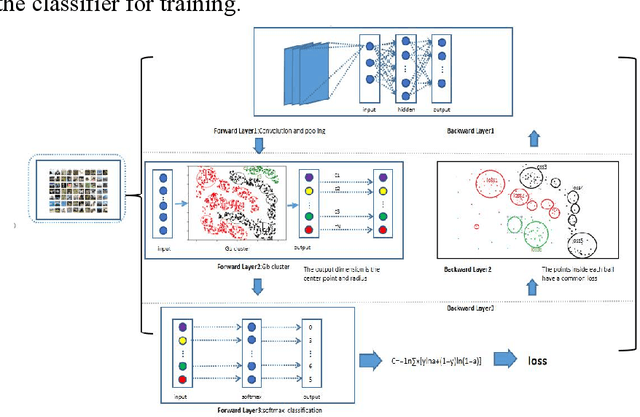

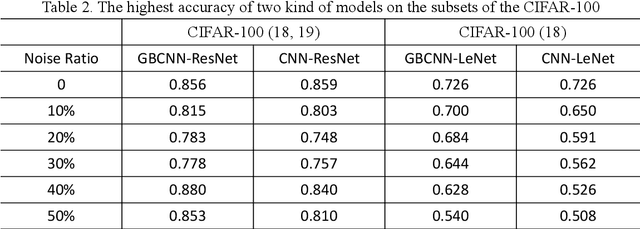
Abstract:In supervised learning, the presence of noise can have a significant impact on decision making. Since many classifiers do not take label noise into account in the derivation of the loss function, including the loss functions of logistic regression, SVM, and AdaBoost, especially the AdaBoost iterative algorithm, whose core idea is to continuously increase the weight value of the misclassified samples, the weight of samples in many presence of label noise will be increased, leading to a decrease in model accuracy. In addition, the learning process of BP neural network and decision tree will also be affected by label noise. Therefore, solving the label noise problem is an important element of maintaining the robustness of the network model, which is of great practical significance. Granular ball computing is an important modeling method developed in the field of granular computing in recent years, which is an efficient, robust and scalable learning method. In this paper, we pioneered a granular ball neural network algorithm model, which adopts the idea of multi-granular to filter label noise samples during model training, solving the current problem of model instability caused by label noise in the field of deep learning, greatly reducing the proportion of label noise in training samples and improving the robustness of neural network models.
One-Stage Deep Edge Detection Based on Dense-Scale Feature Fusion and Pixel-Level Imbalance Learning
Mar 17, 2022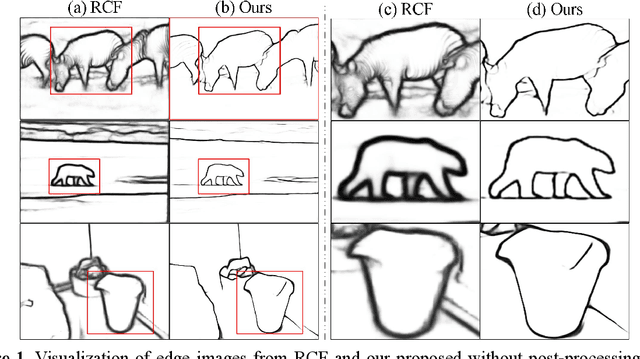
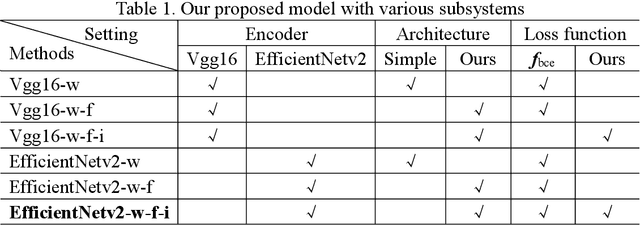
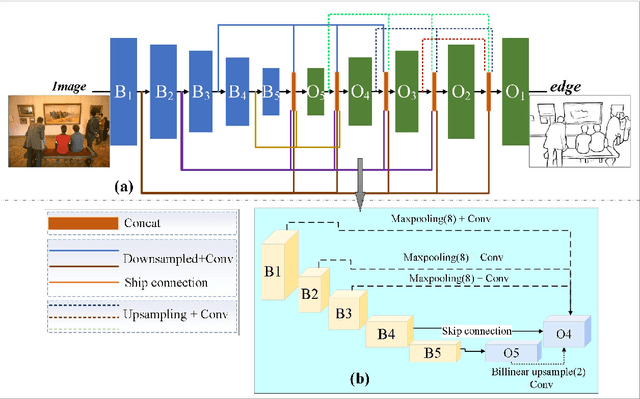
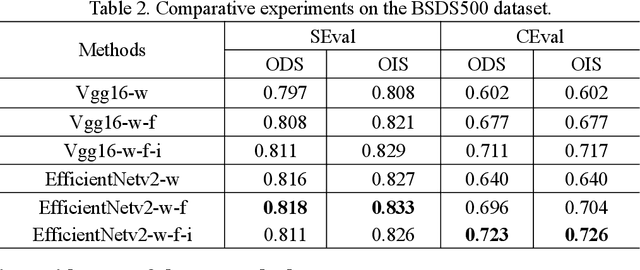
Abstract:Edge detection, a basic task in the field of computer vision, is an important preprocessing operation for the recognition and understanding of a visual scene. In conventional models, the edge image generated is ambiguous, and the edge lines are also very thick, which typically necessitates the use of non-maximum suppression (NMS) and morphological thinning operations to generate clear and thin edge images. In this paper, we aim to propose a one-stage neural network model that can generate high-quality edge images without postprocessing. The proposed model adopts a classic encoder-decoder framework in which a pre-trained neural model is used as the encoder and a multi-feature-fusion mechanism that merges the features of each level with each other functions as a learnable decoder. Further, we propose a new loss function that addresses the pixel-level imbalance in the edge image by suppressing the false positive (FP) edge information near the true positive (TP) edge and the false negative (FN) non-edge. The results of experiments conducted on several benchmark datasets indicate that the proposed method achieves state-of-the-art results without using NMS and morphological thinning operations.
Multi-granularity Association Learning Framework for on-the-fly Fine-Grained Sketch-based Image Retrieval
Jan 13, 2022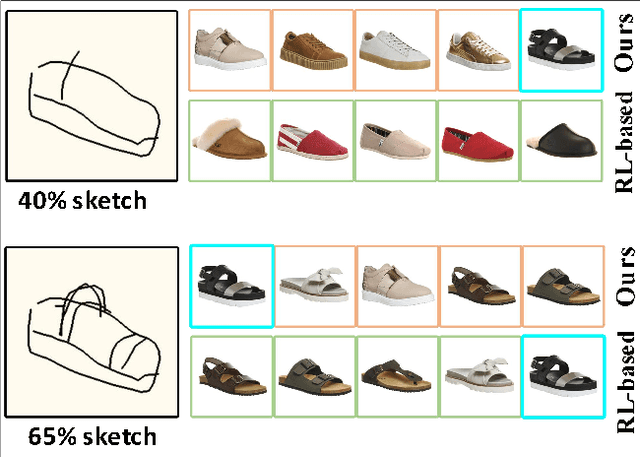

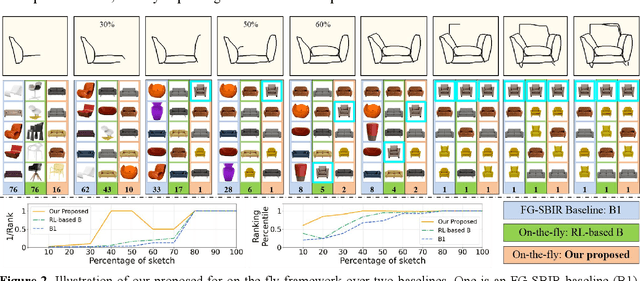

Abstract:Fine-grained sketch-based image retrieval (FG-SBIR) addresses the problem of retrieving a particular photo in a given query sketch. However, its widespread applicability is limited by the fact that it is difficult to draw a complete sketch for most people, and the drawing process often takes time. In this study, we aim to retrieve the target photo with the least number of strokes possible (incomplete sketch), named on-the-fly FG-SBIR (Bhunia et al. 2020), which starts retrieving at each stroke as soon as the drawing begins. We consider that there is a significant correlation among these incomplete sketches in the sketch drawing episode of each photo. To learn more efficient joint embedding space shared between the photo and its incomplete sketches, we propose a multi-granularity association learning framework that further optimizes the embedding space of all incomplete sketches. Specifically, based on the integrity of the sketch, we can divide a complete sketch episode into several stages, each of which corresponds to a simple linear mapping layer. Moreover, our framework guides the vector space representation of the current sketch to approximate that of its later sketches to realize the retrieval performance of the sketch with fewer strokes to approach that of the sketch with more strokes. In the experiments, we proposed more realistic challenges, and our method achieved superior early retrieval efficiency over the state-of-the-art methods and alternative baselines on two publicly available fine-grained sketch retrieval datasets.
 Add to Chrome
Add to Chrome Add to Firefox
Add to Firefox Add to Edge
Add to Edge